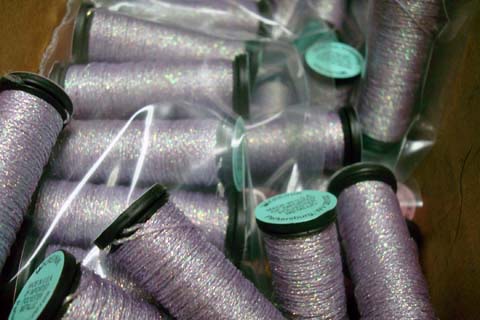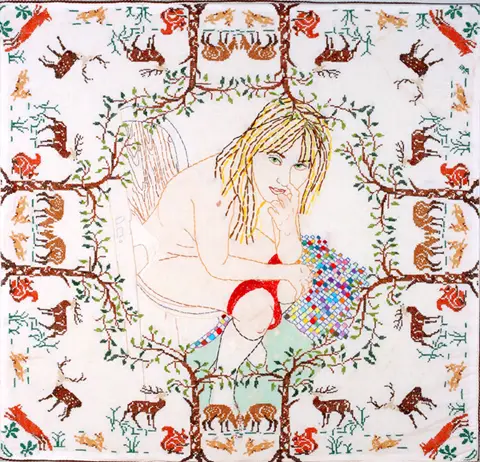In the last four weeks, Kreinik staff members have been to Los Angeles, New York City, Birmingham (England), and Nashville. This glamourous travel schedule was courtesy of hobby industry trade shows covering needlework, machine embroidery, and crafts. Since these shows are for wholesale businesses only, I want to take you behind the flame-retardant, poly-sateen trade-show curtain for a little peek.
Trade shows are truly the land of Oz for any particular industry. When I attend shows for Kreinik, I walk the aisles wishing that everyone could see the beautiful embroideries, fabrics, fibers, and designs that I get to see and live with for three days. Gathered in one place are gadgets you must have, fabrics you want to use, threads you can’t live without, and designs (art!) you simply must make — everything we love as creative people.
Some of the best teachers and designers in the world are there too; you can learn a new technique from the Queen of [insert technique here], or pick up the literally hot-off-the-press book signed by the author. At some shows, you meet TV celebrities (Ty Pennington at Quilt Market, Deborah Norville, Jane Seymour, Vanna White at CHA). For me, needlework designers are celebrities. I met Genevieve Brading of Floss & Mischief at the Birmingham show, and was giddy for an hour. I think I hugged her twice. I met and “talked shop” with the man behind a needlework charting software, and felt like I had met Steve Jobs’ creative younger brother.
Consumers aren’t allowed in most trade shows. Why are they closed to the public? Well, based on a business-to-business, traditional sale-of-goods model, stores get to see new products first. Manufacturers/wholesalers sell to companies/retailers who sell to users/consumers. Professional members of a particular trade get to see new products ahead of the general public.
While this isn’t the only way to market a product, and the internet has changed the way everyone buys, trade shows are still a way to do business. It follows the traditions of medieval craftsmen who traveled from town to town showing their wares, and culminates in expo extravaganzas like the annual Consumer Electronics Show in Las Vegas. Sometimes you just need to see merchandise in person—especially when it comes to textiles—and that is what a trade show is all about. It’s where many new, exciting products, people, projects, and trends converge under one roof, and make their way to your favorite artist, web site, and store.
Here at Kreinik, we’ve done trade shows covering needlepoint, knitting, crochet, weaving, spinning, counted thread, cross stitch, sewing, quilting, machine embroidery, fly fishing, crafts, and costumes (where you see everything from geriatric clowns to cheerleaders, from burlesque dancers to, ahem, other costume users). Kreinik does not sell direct to consumers, so we don’t have booths at retail (consumer) shows.
We exhibit at seven to ten trade shows a year. Oh the stories we could tell: almost didn’t have anything to show when our products were stuck in Customs; we’ve forgotten the keys to our crates; Doug Kreinik got stuck in an elevator once and missed the entire tear-down process…I could go on. Shows are always fun and if we have a good show day we treat ourselves to ice cream or chocolate cake.
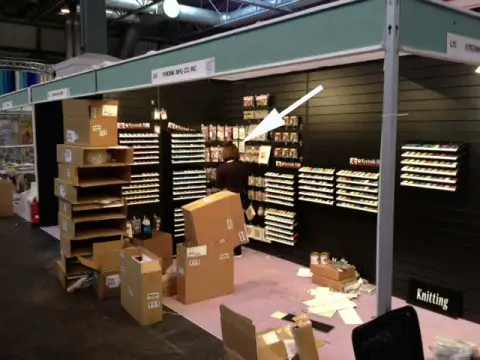
When you exhibit at a show, you rent booth space, electricity, carpet, tables, chairs, drapes, and trash cans. You pay for every item of yours that comes in and out of a convention center (called drayage, or material handling). You, of course, have already paid production costs and had your products made, so then you pay to have that product and booth display shipped (walls, panels, grids, slatwall, pegboard, hooks etc). Sometimes you pay union labor to set up your exhibit. (Side Story of Kreinik Lore: the rule at one convention center stated that if you couldn’t put up your own booth walls in less than half an hour you were required to hire their staff. Doug Kreinik and I proudly put up our 10-foot by 30-foot booth wall system in a record 24 minutes while the labor boss circled us on his bicycle, timing us with his watch. #Boom #Don’tChallengeUs) For the showbook, you buy ad space or pay to have your logo displayed next to your name. You print signs, catalogs and brochures. You cover airfare, gasoline, food and lodging for employees you take to a show. By now you get the idea: a trade show is incredibly expensive. The hope is to get orders that cover all or some of the expenses, but that doesn’t always happen.
So why go? You go to be visible and show off your new stuff. “What’s new?” is the first question you get from your customers, and here is your chance to dazzle them. “I’m new…” is the first statement you get from a potential customer or a new exhibitor, and here is the chance to expand your business. Sure, businesses can easily and cheaply exchange photos or emails about new products. However, at a trade show you get to see, touch, feel, use, learn, sometimes even take home a new product. You can buy from a new vendor that, by meeting/seeing/talking to them, you know would fit in perfectly with your product mix and expansion plans. It’s about live demonstrations, human interaction, and excitement.
At The National NeedleArts Association (TNNA) trade show last month, a needlepoint designer took our new metallic thread color 9032 Easter Braid to other designers, saying “You MUST have this!” (Shameless plug: it’s a cool, prismatic hi-luster-pearl I’ve dubbed “The Chameleon.” The pictures don’t do it justice but check it out here). For the rest of the show, designers were planning, creating, even stitching with it already. At the same trade show, Stories In Stitches designers Ava Coleman and Donna Drachunas were doing knitting-with-Kreinik demonstrations in our booth, and Donna tried out new knitting needles. Shop owners stopped to ask, “What’s that? Where can I get those?” Donna gave them an honest and glowing review. It’s a sample of what happens at a trade show: a designer found a helpful new tool, we learned about something to make working with silk threads better, retailers discovered an exciting product for their stores (you), and a needle-maker found new customers.
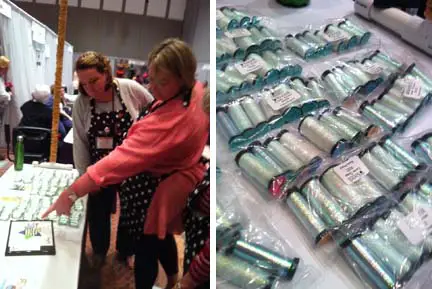
You also go to trade shows because there is power in numbers. The trade organization helps in marketing, advertising, building consumer awareness, and otherwise growing the particular industry. You are not sitting alone at your computer or in an online discussion trying to figure out how to increase business. A group specializing in needlepoint, for instance, gathers to brainstorm, plan, design, and fund programs to bring the beauty, relaxation, art, and fun of needlepoint to everyone in the world. Trade organizations can offer business classes, copyright assistance, market analytics, even health insurance to help businesses of all sizes. We are all just trying to make a living doing something we love. Everyone benefits and the industry grows when we work together. As an example—and I am excited to announce here first—the Counted Thread & Embroidery Group of TNNA will again sponsor a New Designer Program, offering free trade show booth space for up to five budding cross stitch, counted needlepoint, or embroidery designers. It’s a great way to encourage new talent and infuse the industry with freshness. (If you are interested, contact me.)
For us here at Kreinik, a little West Virginia thread manufacturer, this is what trade shows are all about: the people. It’s the networking, the face-to-face interaction that you can’t get from emails, phone calls, and direct mail which creates, enhances, and sustains relationships. We all do business with people: people we know and like, people who understand our businesses and goals. At trade shows you can meet new business owners, talk to shop owners and designers, hear what’s working in their stores, talk about what their customers want, see what they are making. You get to have fun with other people who share the same passions. The Kreiniks have been exhibiting at trade shows for all of the company’s 40+ years. At a TNNA show a few years ago, Doug looked around and said, “I love these people. They are my family.”
Inspiration and creative energy is magnified at our hobby trade shows because of the people, and I wish I could bring all of you with me to these shows. Take a look at the photo albums on our Facebook page for a visual glimpse. We blog or tweet during and after shows, as do designers and shop owners. So keep in touch with your favorite suppliers and you will be in-the-know about exciting new items.
Our little thread is nothing without designers, stitchers, artists, users—without you—who use it for self-expression, business, fun. It has been a crazy busy month and I’m glad this series of trade shows is over. Now we can stay home and make more thread. Thank you for using it; you inspire us every time we see what you’ve made. We already have plans for some really cool top-secret things to be revealed at the next trade show, and always welcome your feedback on what you want to see from Kreinik. Keep in touch.
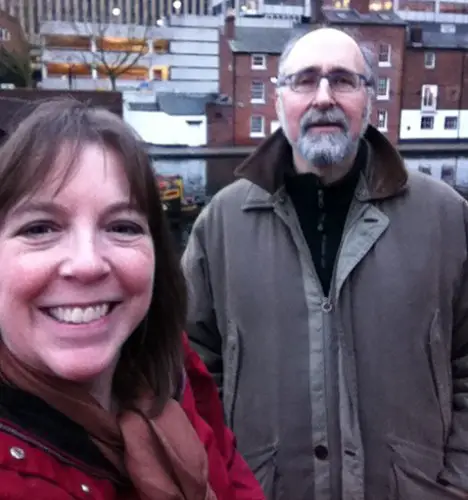
—–
Dena Lenham, aka KreinikGirl, is Creative Director at Kreinik Manufacturing Company, a family-owned, USA-based business that manufactures high-quality yarns and threads made of metallics, silks and real metals from their West Virginia factory.

